#tariq al-ziyad
Text
idc what y’all say i blame Tariq for Rahim’s death 100%
bro wants to act on his own impulse? fine, go ahead, but don’t risk others while you go pull that stupid shit.
#the wrath and the dawn#the rose and the dagger#tariq al-ziyad#shahrzad and khalid#shazi#shahrzad al-khayzuran#irsa al-khayzuran#khalid ibn al-rashid#jalal al-khoury#jahandar al khayzuran#despina vandi#rahim al din walad
29 notes
·
View notes
Text
As I promised, let's start with the bookscans:
Al-ANDALUS. PERSONAJES HISTÓRICOS
(Al Andalus. Historical figures)
Concepción Masiá
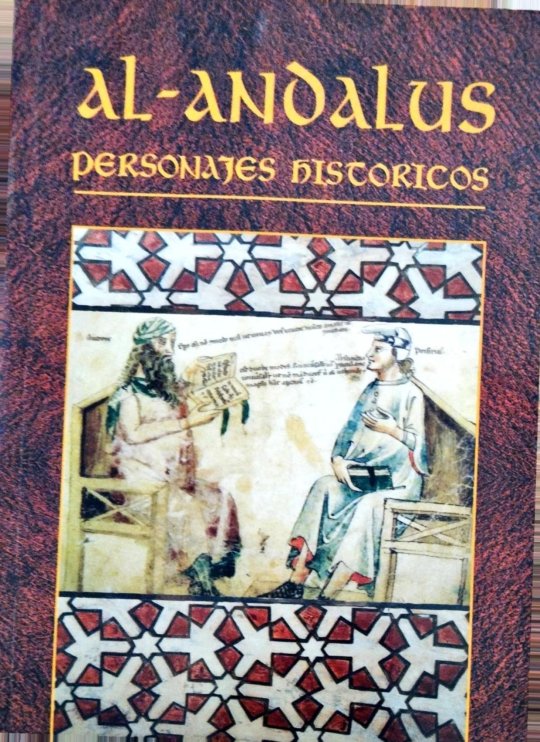
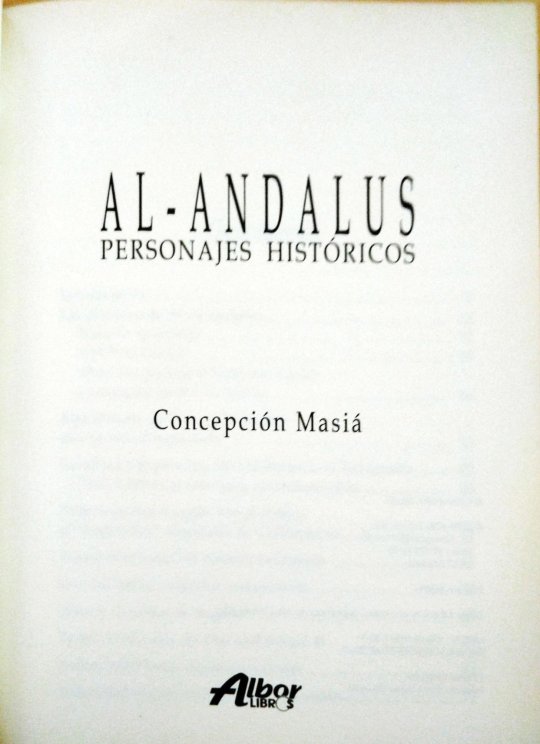

Summary
Introduction.................................. 9
The precursors of al-Andalus.....13
Count Don Julián....................13
Tarif ben Malluk. ....................15
Musa ben Nusayr and Tariq ben Ziyad: the conquerors of Spania...........16
Abd al-Aziz: a good governor with an unfortunate fate ..........................25
The Odyssey of Prince Abd al-Rahman the Immigrant......................................29
Abd al-Rahman was only twenty-five years old.........................................36
Sulayman ben Yaqzan ben al-Arabi: Charlemagne's deceived "deceiver" ........................... ...........41
Amrus ben Yusuf: the muladí of Huesca
.............................................................47
The “rabadies”: adventurous spirits.. ..............................................53
Ziryab: the singer of Baghdad........61
Tarub: the favorite of Abd al-Rahman II...............,...........................................67
Abbas ben Firnas: the first aviator............................ ......................73
Yahya ben Hakan al-Bakri: the miserly poet.....................................................77

Abd al Chabbar and Sulayman ben Martin: the rebels of Mérida..........................81
Eulogio and Álvaro de Córdoba:
pursuing martyrdom..........................85
The Andalusian Vikings..................... 95
The emir Abd Allah distrust and death...............................….................... 101
Musa ben Musa ben Qasi: the third king of Spain.......................................................107
Ibn Hafsun: the unredeemed rebel.....115
Abu Alí al-Sarrach: the Andalusian missionary. ...........................................125
Ibn Masarra: a freethinker in Spanish Islam.......,...........,...................................131
Abd al-Rahman III:
the first independent caliph of al-Andalus. ...........,................................137
Hasday ibn Shaprut:
the Jewish doctor of Abd al-Rahman III............ ....... ...................... ................... 145
Andalusians in France: the “Moorish kingdom” of Fraxinetum....................... 151
Rabbi ben Zayd: Bishop Recemundo............................................. 157
Al-Hakam al-Mustansir bi-llah:
passion for culture.................................. 161
Ibn Abd Rabbhi, the encyclopedist,
and Ibn Futais, the collector.................. 167
Al-Mansur “the Victorious” ...................171
Hisham II and Sanchuelo: misrule. .......191
Abu Muhammad Ali ibn Hazm:
The pigeon neackle................................209
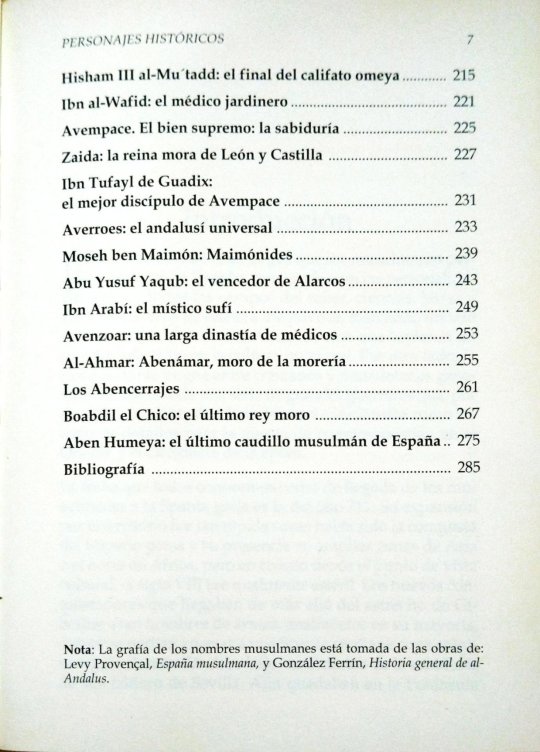
Hisham III al-Mu'tadd: the end of the Umayyad caliphate...............................215
Ibn al-Wafid: the gardener doctor.....221
Avempace. The supreme good: wisdom...................................................225
Zaida: the Moorish Queen of Leon and Castile........................................................227
Ibn Tufayl of Guadix:
the best disciple of Avempace................. ............................ .231
Averroes: the universal Andalusian....233
Moseh ben Maimon: Maimonides..... ..239
Abu Yusuf Yaqub: the winner of Alarcos......................................................243
Ibn Arabi: the Sufi mystic.....................249
Avenzoar: a long dynasty of doctors. ...................................................253
Al-Ahmar: Abenámar, Moor of the Morería. ...,...............................................255
The Abencerrajes. ..................................261
Boabdil the Younger: the last Moorish king ............................................................267
Aben Humeya: the last Muslim leader of Spain................ ..........................................275
Bibliography .............................................285
Note: The spelling of Muslim names is taken from the works of: Levy Provençal,
Muslim Spain, and González Ferrín, General History of al-Andalus.

Introduction
In the long eight hundred years that the Muslims remained in Spain, there were many personalities who, in all the fields of knowledge, sciences, letters and arts, stood out unequivocal, marking a milestone not only in the culture of al-Andalus, but that had a relevant character in universal culture.
On the other hand, the almost constant struggle between Christians and Muslims would also generate a whole series of great warriors who, for example, the infante Don Juan Manuel considered the best gifted for the war of all those who existed in the East and the West of their time.
The date that we all know as the arrival of the Muslims to Gothic Spania dates back to the year 711. Its expansion throughout the territory was so rapid as had been the conquest of the Persian empire and its presencein large areas of Asia or North Africa, but from a cultural point of view, the 8th century was totally sterile. The new conquerors who arrived from beyond the Strait of Gibraltar, were men at arms, mostly illiterate, who could do little contribute to a Christian Spania whose culture continued to develop under the dictates of the wisdom of Saint Isidore of Seville. Still they were left on the Peninsula
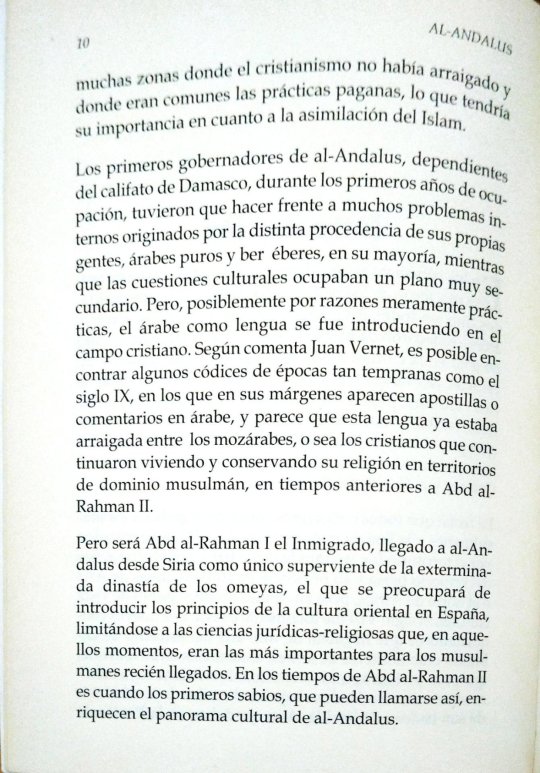
many areas where Christianity had not taken root and its importance regarding the assimilation of Islam.
The first governors of al-Andalus, dependent on Caliphate of Damascus, during the first years of occupation
had to face many enormous internal problems, originated by the different origins of their own people, Arabs
and berebers, mostly, while cultural issues occupied a very secondary level. But, possibly for purely practical reasons, Arabic as a language was introduced into the Christian field. According to Juan Vernet, it is possible to find
some codices from times as early as the 9th century, that in its margins appear apostilles or comments in Arabic,
and it seems that this language was already rooted among the Mozarabs,
that is, the Christians who continued to live and preserve their religion in Muslim-dominated territories, in times
before Abd al-Rahman II.
But it will be Abd al-Rahman I the Immigrant, who arrived in al-Andalus from Syria as the only survivor of the exterminated Umayyad dynasty, the one who will be concerned with introducing the principles of oriental culture in
Spain, limiting itself to the legal-religious sciences that, in those moments, were the most important for the newly Muslims
arrived. It was during the time of Abd al-Rahman II that the first wise men, who can be called that, enrich the cultural landscape of al-Andalus.

Poets, doctors, philosophers, mathematicians, geographers, undefeated generals...All of them will give al-Andalus and Europe a series of works that, by their importance will be translated, searched, accepted and will serve as a basis for the western culture and Renaissance ideas, in such a way that many of the great sages of the Italian Renaissance considered that all knowledge of the time came from Muslim Spain, which all the wise men were of Andalusian origin. And when the political decline and the disintegration of the caliphate, will not stop birth, grow and develop distinguished minds that will continue to maintain,for a long time, the prestige of al-Andalus. Curiously, this situation will be repeated throughout the history of Spain, when the Arab occupation just be a memory. The Spanish Golden Age will coincide with decadence of the Austrias, when the country loses its pre-ponderance in Europe, and with the disaster of '98, with the loss for Spain of its last colonies, will produce a cultural and scientific renaissance that has been called the Silver age.
Through the pages of this book we want to highlight those figures who occupied a predominant place in the history of al-Andalus, although not all of them were necessarily Muslims, since that in that cultured and tolerant al-Andalus, many Jews and some other Christians showed their genius, and of those who, often, we know more about his works than about his biography. But whatever religion they had, they were all, after all, Andalusians, born and raised in the extensive lands of al-Andalus. As a matter of curiosity we will include some groups of characters
anonymous people who, due to their surprising
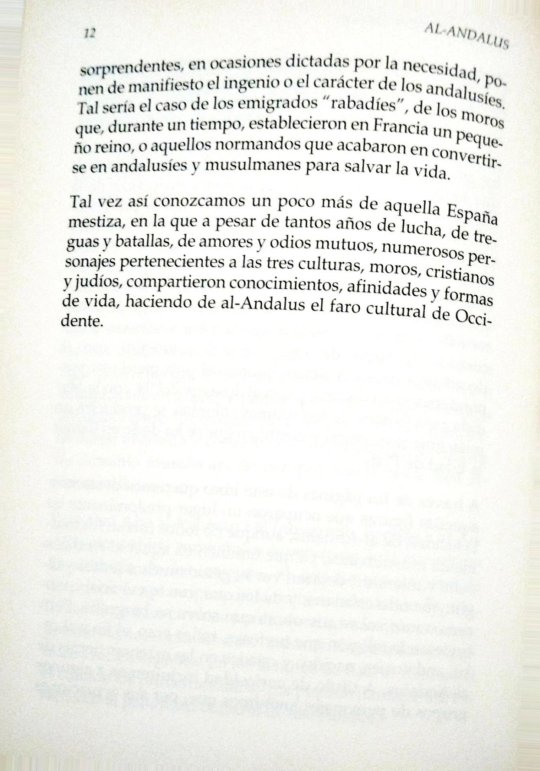
actions, on occasions dictated by necessity, they reveal the ingenuity or character of the Andalusians. Such would be the case of the "rabadíes", of the Moors who, for a time, established a small kingdom in France, or those Normans who ended up becoming Andalusians and Muslims to save their lives.
Perhaps this way we will learn a little more about that crossbred Spain, in which despite so many years of struggle, truces and battles, mutual loves and hates, numerous characters belonging to the three cultures, Moors, Christians and Jews shared knowledge, affinities and forms of
life, making al-Andalus the cultural beacon of the West.

The precursors of al-Andalus
Count Don Julián
The conquest of Morocco had been carried out quickly, but shallow. The Berbers were only subdued after a fierce resistance, defeated by an ambitious general who had just been appointed governor of Ifriqiya and Maghrib. His successes in these lands
They would prepare the ground for him to be the one to set his eyes and, also
his troops, over Gothic Spania. It was Musa ben Nusayr.
Musa, with the help of one of his sons, took possession of Tangier, and demanded that the subjugated tribes hostage to educate them in the new faith, which in turn, became propagandists of Islam, leaving in the conquered Morocco
Arab lieutenants, including General Tariq ben Ziyad, he turned to Ifriqiya. But it seems that the Ceuta square remained
in the hands of a Christian, the so-called Count Don Julián, who would have a
determining role in this entire story. We could consider it as a precursor of that al-Andalus that was about to be born.
#bookblr#book scans#historyblr#history books#al andalus#al andalus. personajes históricos#al andalus. historical figures#history#spanish history#musa ibn nusayr#tariq ibn ziyad#conde don julián#count don julián#count julian
27 notes
·
View notes
Text



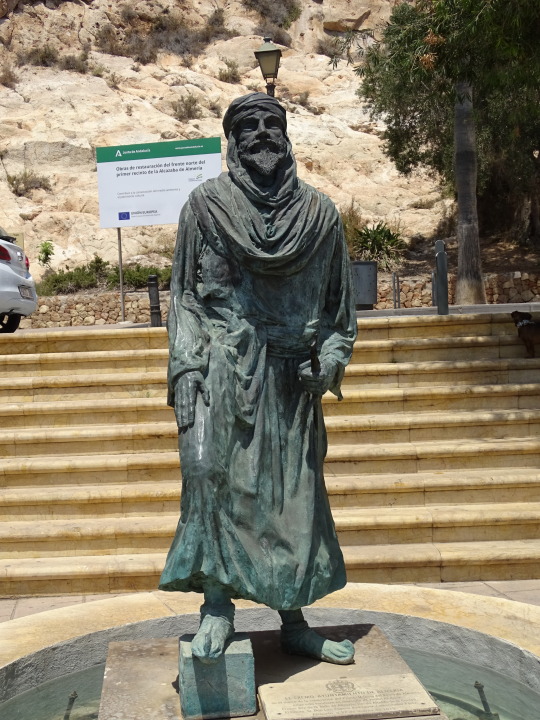
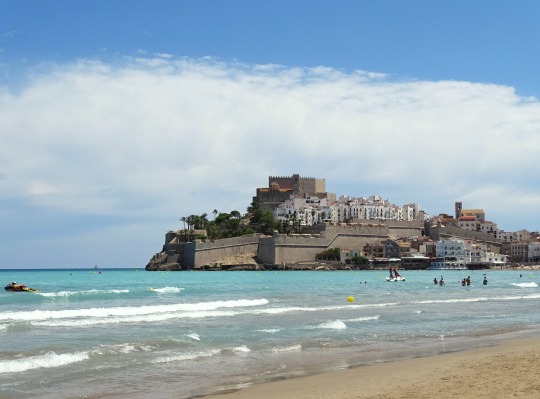


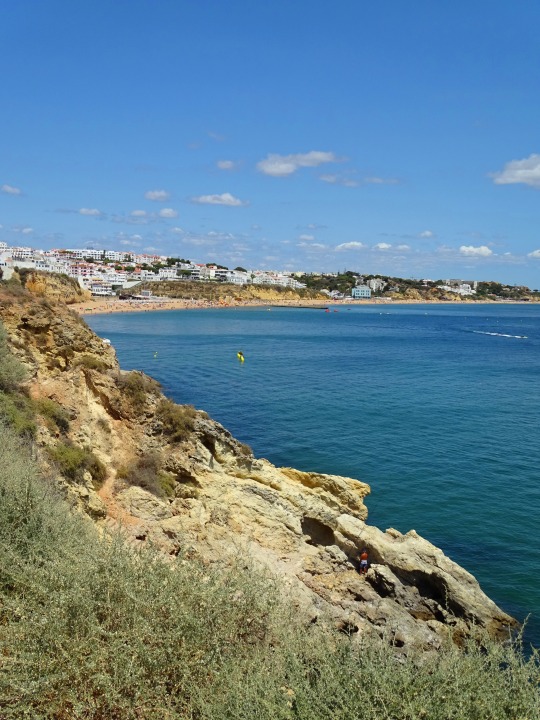




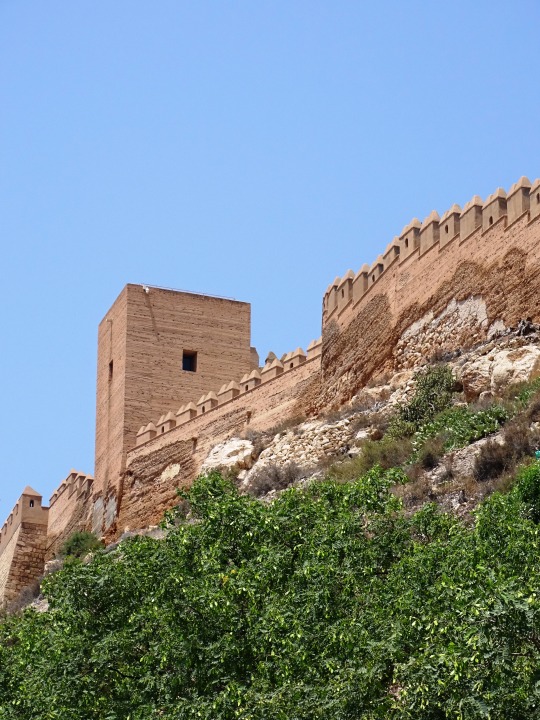

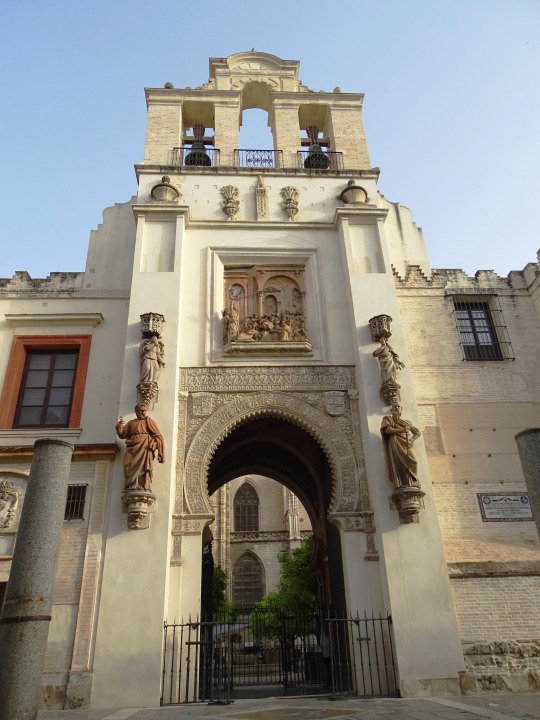

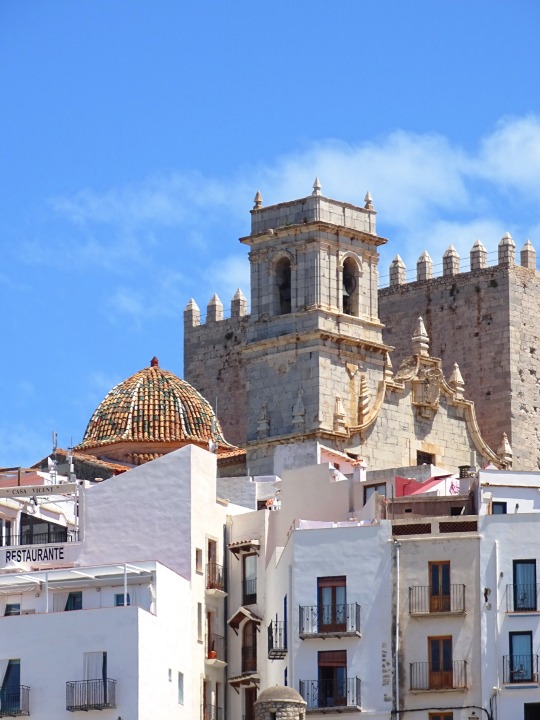



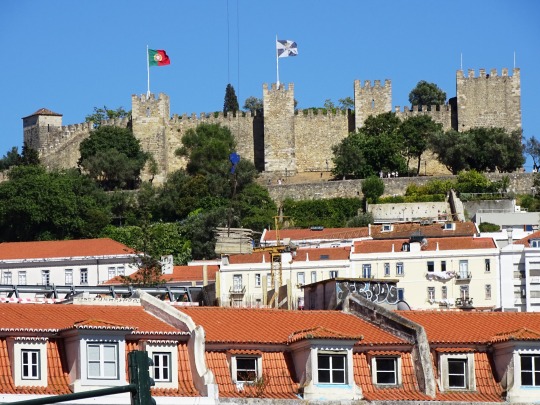
Islamic conquest of Hispania: Moorish troops led by Tariq ibn Ziyad land at Gibraltar to begin their invasion of the Iberian Peninsula (Al-Andalus) on April 27, 711.
#Alcazaba y Murallas del Cerro de San Cristóbal#Almería#Jayran al-Amiri#Reales Alcázares de Sevilla#Islamic conquest of Hispania#Tariq ibn Ziyad#begin#invasion#Iberian Peninsula#Spanish history#travel#Portuguese history#summer 2021#original photography#Sevilla#Castillo De La Calahorra#São Jorge Castle#Lisbon#Portugal#Spain#España#Gate of Forgiveness#Seville Cathedral#Castelló de Farfaña#Castillo de Peñíscola#Mediterranean Sea#Albufeira#Atlantic Ocean#vacation#27 April 711
7 notes
·
View notes
Text

Moor or Moreno is a Spanish word that has several meanings, including "dark-skinned" or "brown-skinned". It can also refer to someone who has a dark complexion.
The Moors who rulled Spain..
Tariq ibn-Ziyad
In A.D. 711, a group of North African Muslims led by the Berber general, Tariq ibn-Ziyad, captured the Iberian Peninsula (modern Spain and Portugal). Known as al-Andalus, the territory became a prosperous cultural and economic center where education and the arts and sciences flourished.12 Dec 2019
Ancient African Kingdoms
Black history
79 notes
·
View notes
Text

WHEN BLACK-MEN RULED THE WORLD
Some Things You Did Not Know About the Moors of Spain
1. The Spanish occupation by the Moors began in 711 AD when an African army, under their leader Tariq ibn-Ziyad, crossed the Strait of Gibraltar from northern Africa and invaded the Iberian peninsula ‘Andalus’.
2. A European scholar sympathetic to the Spaniards remembered the conquest in this way:
a. The reins of the Moors horses were as fire, their faces black as pitch, their eyes shone like burning candles, their horses were swift as leopards and the riders fiercer than a wolf in a sheepfold at night . . . The noble Goths [the German rulers of Spain to whom Roderick belonged] were broken in an hour, quicker than tongue can tell. Oh luckless Spain!
Quoted in Edward Scobie, The Moors and Portugal’s Global Expansion, in Golden Age of the Moor, ed Ivan Van Sertima, US, Transaction Publishers, 1992, p.336
3. The Moors, who ruled Spain for 800 years, introduced new scientific techniques to Europe, such as an astrolabe, a device for measuring the position of the stars and planets. Scientific progress in Astronomy, Chemistry, Physics, Mathematics, Geography and Philosophy flourished in Moorish Spain.
4. Basil Davidson, one of the most noted historians recognized and declared that there were no lands at that time (the eighth century) “more admired by its neighbours, or more comfortable to live in, than a rich African civilization which took shape in Spain”
5. At its height, Córdova, the heart of Moorish territory in Spain, was the most modern city in Europe and the world. The streets were well-paved, with raised sidewalks for pedestrians. During the night, ten miles of streets were well illuminated by lamps. This was hundreds of years before there was a paved street in Paris or a street lamp in London. Cordova had 900 public baths – we are told that a poor Moor would go without bread rather than soap while the then
Queen of England never had a bath!
6. The Great Mosque of Córdoba (La Mezquita) is still one of the architectural wonders of the world in spite of later Spanish disfigurements. Its low scarlet and gold roof, supported by 1,000 columns of marble, jasper and and porphyry, was lit by thousands of brass and silver lamps which burned perfumed oil.
7. Education was universal in Moorish Spain, available to all, while in Christian Europe more than ninety-nine percent of the population were illiterate, and even kings could neither read nor write. At that time, Europe had only two universities copied from Spain, the Moors had seventeen great Universities! These were located in Almeria, Cordova, Granada, Juen, Malaga, Seville, and Toledo in which the majority of the lecturers were women.
8. In the tenth and eleventh centuries, public libraries in Europe were non-existent, while Moorish Spain could boast of more than seventy, of which the one in Cordova housed six hundred thousand manuscripts.
9. Over 4,000 Arabic words and Arabic-derived phrases have been absorbed into the Spanish language. Words beginning with “al,” for example, are derived from Arabic. Arabic words such as algebra, alcohol, chemistry, nadir, alkaline, and cipher entered the language. Even words such as checkmate, influenza, typhoon, orange, and cable can be traced back to Arabic origins.
10. The most significant Moorish musician was known as Ziryab, the Blackbird who arrived in Spain in 822. The Moors introduced earliest versions of several instruments, including the Lute or el oud, the guitar or kithara and the Lyre. Ziryab changed the style of eating by breaking meals into separate courses beginning with soup and ending with desserts.
11. The Moors introduced paper to Europe and Arabic numerals, which replaced the clumsy Roman system.
12. The Moors introduced many new crops including the orange, lemon, peach, apricot, fig, sugar cane, dates, ginger and pomegranate as well as saffron, sugar cane, cotton, silk and rice which remain some of Spain’s main products today.
13. The Moorish rulers lived in sumptuous palaces, while the monarchs of Germany, France, and England dwelt in big barns, with no windows and no chimneys, and with only a hole in the roof for the exit of smoke. One such Moorish palace ‘Alhambra’ (literally “the red one”) in Granada is one of Spain’s architectural masterpieces. Alhambra was the seat of Muslim rulers from the 13th century to the end of the 15th century. The Alhambra is a UNESCO World Heritage Site
14. It was through Africa that the new knowledge of China, India, and Arabia reached Europe. The Moors brought the Compass from China into Europe.
15. The Moors ruled and occupied Lisbon in Portugal (named “Lashbuna” by the Moors) and the rest of the country until well into the twelfth century. They were finally defeated and driven out by the forces of King Alfonso Henriques. The scene of this battle was the ‘Castle of St. George.’
Beginning in the 12th century and continuing for hundreds of years, the Inquisition was infamous for the severity of its tortures and its persecution of Jews and Muslims. Its worst manifestation was in Spain, where the Spanish Inquisition was a dominant force for more than 200 years, resulting in some 32,000 executions.
152 notes
·
View notes
Text
Israeli army drops leaflets, orders Palestinians to leave Gaza City
youtube
The Israeli army ordered all Gaza City residents on Wednesday to evacuate and move towards Deir el-Balah. The military distributed leaflets urging residents to leave immediately and head south towards Zawaida and Deir el-Balah.
The leaflets warned that "Gaza City will be a dangerous combat zone" and provided instructions on safe evacuation routes via the Salah al-Din road or the coastal road. Specific safe corridors include “Tariq bin Ziyad” and “Omar al-Mokhtar” streets for crossing west to Al-Rashid (al-Bahr) Street, and “Al-Wahda” and “Khalil Al-Wazir” streets for crossing east to the “Al-Zaytoun neighbourhood” and “the city roundabout,” and from there to the south through “Salah al-Din” street.
Campaigners question the use of the word “evacuation” as Israel has forced Palestinians to flee multiple times since the war began in October, and Israeli forces have repeatedly attacked so-called “safe zones” where Palestinians were asked to relocate.
Al Jazeera’s Hamdah Salhut joins us from Amman, Jordan, and Hind Khoudary joins us from Deir Al Balah in central Gaza to discuss the latest updates.
13 notes
·
View notes
Text




Only a small amount of photos and videos reaches us from the Gaza Strip, but this doesn't mean the genocide has stopped. In the last 24 hours, the Occupation committed 16 massacres resulting in 163 martyrs and 350 wounded. The Occupation warplanes haven't stopped their raids on various areas of the Strip. The most violent bombing was in Khan Younis, where even graves weren't spared the Occupation's targeting and exhumation. The toll of the ongoing genocide has amounted to 24,448 martyrs.
4 out of 5 of the hungriest people anywhere in the world are in Gaza, announced the 3 international organizations: WFP, UNICEF, and WHO. This means that the possibility of a famine in Gaza increases daily, threatening 2.3 million people in the Strip. Nothing will stop this monster except for one thing, a radical change in the flow of humanitarian aid, urgently and immediately. Does Egypt hear these calls? Or does it need to wait until famine cripples the people of the Gaza Strip?
• 1,000 boxes of medicine for each box of medicine that enters for the Israeli prisoners, that was Ha*mas's condition after agreeing to the Occupation's pleas to enter medicine to its prisoners. Not because it cares for them, but to subdue the anger of its society that has been increasing its demands to end this losing war for the Occupation army. Ha*mas assured that these medicines will be for the people of Gaza and are to be distributed to 4 hospitals in the Strip, under the condition that the Occupation doesn't search these shipments.
In the 24 hours preceding the 103rd day, the Occupation committed 16 massacres in Gaza, resulting in 163 martyrs and 350 injuries, as documented by the Ministry of Health. The actual numbers may be even higher.
Just as the massacres have not ceased, the Occupation's crime of cutting off communication and internet in most of Gaza continues for the sixth consecutive day. Documenting these events is challenging, and many instances of bombardment go unnoticed.
Do you remember the feeling during Baptist Hospital Massacre? And the day al-Shifa' Hospital was besieged? Perhaps your anger subsided, but the Israeli crimes did not cease and their severity did not diminish. The Occupation tanks advanced towards Nasser Hospital in Khan Younis early Wednesday (Jan. 17), shelling its surroundings, targeting Tariq bin Ziyad School nearby, which sheltered hundreds of displaced people. The Israeli tanks and forces also dug up a nearby cemetery, desecrated graves, scattered bones, and stole several corpses. They then withdrew after intense clashes with the Resistance.
#gaza#free gaza#gaza strip#palestine#gazagenocide#gaza news#gazaunderfire#gazaunderattack#free palestine#save gaza
29 notes
·
View notes
Text






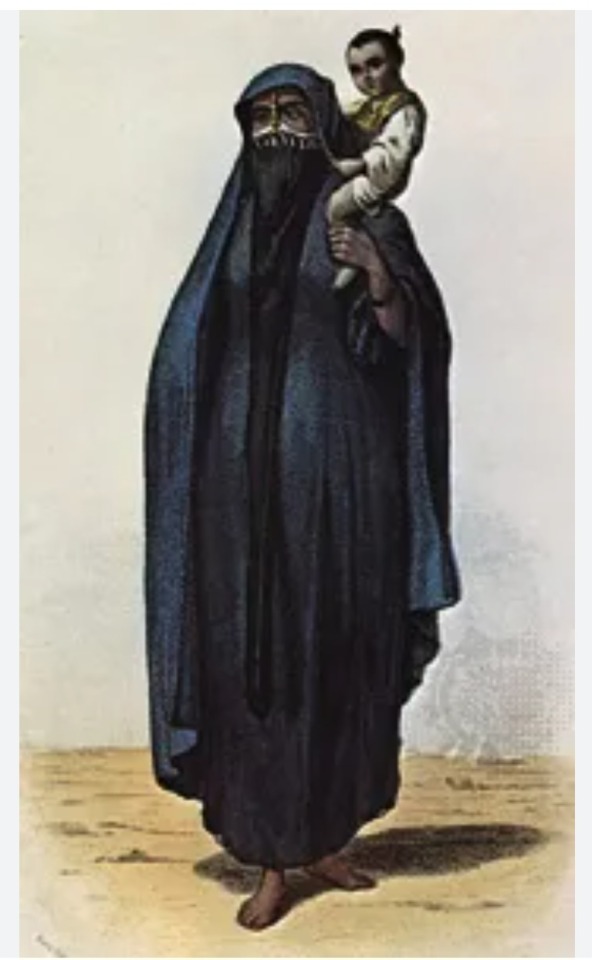
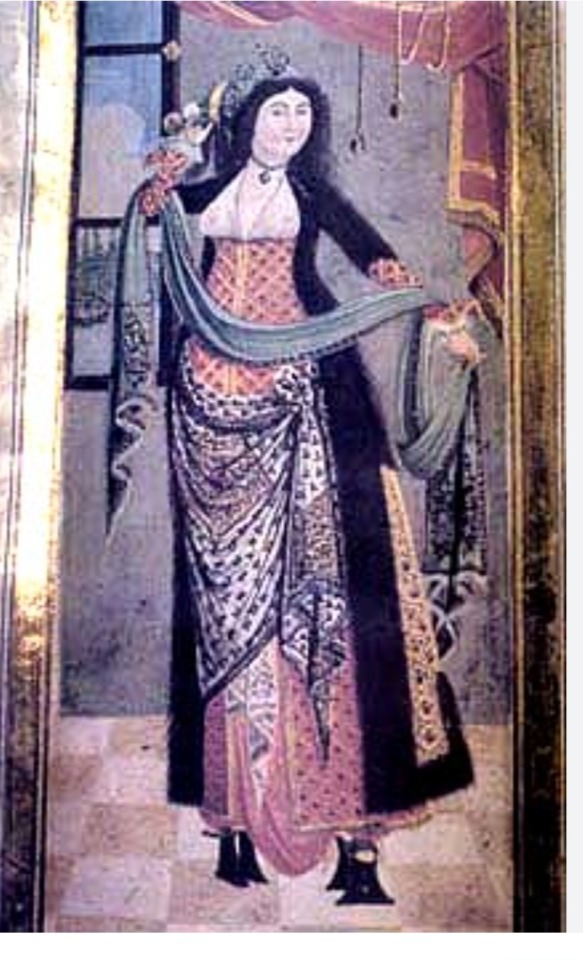
A collage I made of Queen Nymeria of Dorne's fashions
During the 5th century AD, 1000 years before the events of GOT series, the Rhohynar Empire began to take form after the fall of the Valyrian Empire.
Nymeria is a Princess of the Rhohynar who led fleets in her conquest of Dorne, and thus becoming founder of the Martell dynasty in Dorne and first Martell Queen of Dorne.
I imagine her fashions having nods to the fashions of Tariq Ibn Ziyad ( leader of the Islamic conquest of Hispania ), Fatima Al Fihri ( founder of the first university in the world, University of Al Qarawiyyin ), Al Khayzuran ( Abbasid Empress and mother of Caliph Harun Al Rashid ), and Ismat Ad Din Khatun ( first Ayyubid Empress and Saladin's chief wife )
9 notes
·
View notes
Text
On 26 October, the Palestinian Ministry of Health released the list of names of Palestinians killed since 7 October. Among them, from the Abu Omra family, are:
Fatima Muhammad Ali (91);
Rabaa Ayada Hamidan (74);

Muhammad Ibrahim Nassar (72) and his brother Mahmud Ibrahim Nassar (62);



Hamidan Muhammad Ayada (68) and his sons Muhammad Hamidan Muhammad (35) and Abdullah Hamidan Muhammad (32);
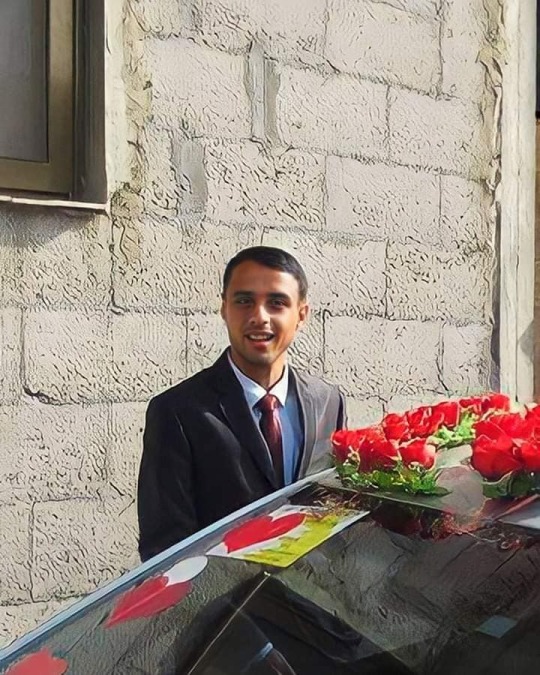


Hamidan’s son Imad Hamidan Muhammad (38) and his son Hamza Imad Hamidan (6);
and Hamidan’s son Ziyad Hamidan Muhammad (34), his wife Hind Talbani, and their son Tariq Ziyad Hamidan (1);
Najah Ali Muhammad (47);
Ikram Hamidan Muhammad (40);
Islam Sabah Khalil (33);
Nihad Ismail Ibrahim (29);
Salim Suleiman Ahmed (28);
Nur al-Din Muhammad Salman (27);
Nur Ibrahim Muhammad (21) and her brothers Muhammad Ibrahim Muhammad (16) and Ali Ibrahim Muhammad (11);
Samiya Ahmed Saleh (18) and her brother Ibrahim Ahmed Saleh (7);
Muhammad Salim;
Atiya Salman, a baby;
Yahya Muhammad, a child;

Nur Muhammad;
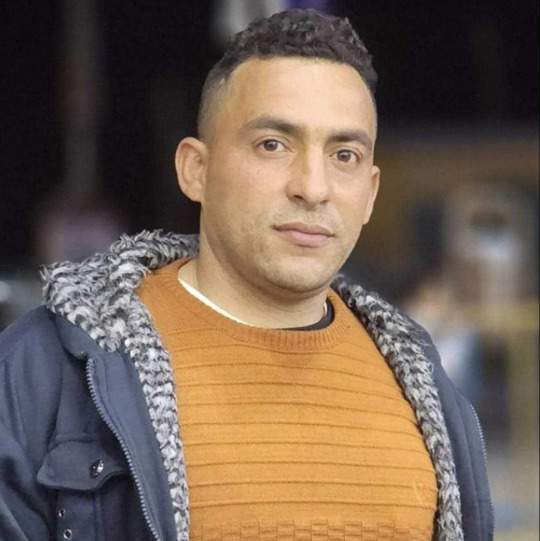
and Mustafa Anwar.
You can read more about the human lives lost in Palestine on the Martyrs of Gaza Twitter account and here.
6 notes
·
View notes
Text
Our parents fled war. They fled oppression and torture. Here you are indulged in sin that would make your mother and father cry. Is this what they risked their lives for? From the blood soaked sands of Badr, where the sahabah fought valiantly to the scent of burning timber at the banks of Gibraltar, where the Berber lion Tariq ibn Ziyad burned the ships to eradicate retreat as an option. Behind you is the sea. Before you is the enemy. So where will you flee? As he said to his army. From the liberation of Jerusalem by the Kurdish general Salahaddin Al Ayyub to the collapse of the walls of Constantinople which led the Turkish Sultan Mohammed Al Fateh to break the reign of Byzantium in the glorious city. All these men from different backgrounds fought under one banner the banner of Al-Islam. All these lives, all this sacrifice just for you to forsake your religion, for your desires. One day your desires will turn against you. Repent and return for the grave is dark, lonely and full of regrets.
16 notes
·
View notes
Text
The Reconquista & Moorish Resistance in Spain: Rebellion of the Alpujarras (1499-1501)
1492 was one of the most consequential years for the nationhood of what is now Spain. Not only was it the year Christopher Columbus & his crew reached the Americas in the name of the Spanish monarchs. An event that ignited the subsequent centuries long European exploration & conquest of the North American & South American continents. 1492 was also the year that most historians deemed the official end of the so-called Reconquista.
The Reconquista (reconquest) was also commonly viewed as a centuries long project of entailing conflict between the Christian kingdoms of the Iberian Peninsula (modern Spain & Portugal) aimed at “retaking” the land from the Islamic invaders who hailed from North Africa & the Middle East and ruled over large swaths of land collectively known as Al-Andalus. The grouping of Muslims in Iberia came to collectively be referred to as the Moors. As we’ll elaborate in this post, the Reconquista fitting into a binary Christian European versus foreign Muslim narrative is probably too narrow to accurately the describe the period in question. Nor as we’ll discuss later does the year 1492 automatically signal an end to the Moorish community such as it was within Iberia. As with much of history there is much more nuance to these topics. To get a more accurate picture of history requires accepting that nuance however inconvenient to our preconceived notions did in fact & does in fact exist in virtually every historical event recorded across the spans of time & space.
Let’s then define the rough time period we mean, when we discuss the Reconquista. Historians commonly refer to the Reconquista to be roughly from the year 718/722 AD/CE starting with the Battle of Covadonga lasting until the Fall of Granada in 1492 AD/CE. These are generally the bookends of Reconquista which are more or less accepted by historians today. For further context, let’s remind ourselves of what brought about the Reconquista & then discuss whether that it was a simple case of Christian vs. Muslim.
The Islamic Conquest of the Iberian Peninsula is generally believed to have begun in the year 711 AD/CE when a force of Muslims made up of mostly Berber or Amazigh (native peoples from North Africa) with some Arabs crossed the Straits of Gibraltar from modern Morocco & invaded modern-day Spain. This force was led by one Tariq ibn Ziyad (670 CE-720 CE). Tariq was a Berber from North Africa whose people had only within the last few decades come to embrace Islam & not completely. The early Islamic conquests spread rapidly following the death of the Prophet Muhammad in 632 CE. Muhammad had largely succeeded in uniting the Arabian Peninsula under Islamic rule by his death. From there under the first Islamic empire of sorts, the Rashidun Caliphate (632 CE-631 CE) saw conquests of both some of the Middle East and some of North Africa, namely Egypt from the Eastern Roman Empire (Byzantine Empire) & Iranian Plateau from the Persian Sassanian Empire. Following the First Fitna (civil war), the Rashidun Caliphate was succeeded following the death of Muhammad’s cousin & son-in-law Ali ibn Abi Talib, the 4th and final caliph of the Rashidun (rightly guided). They were succeeded by the Umayyad Caliphate (661 CE-750 CE), the 2nd major Islamic caliphate. The Umayyads were an Arab dynasty & distant relatives of Muhammad taking power after the First Fitna from their power base in Syria. They changed the trajectory of Islamic history in a number of ways. In a leadership level, they became the first hereditary Islamic dynasty, making the caliph less of a religious & political leader & primarily a political leader akin to a king or emperor in practice though nominally had the religious leadership attached to the title but this would decrease in practice overtime. The succession of caliphs were now passed essentially from father to son whereas the Rashidun caliphs were elected by a council called a shura who tried to assess the merits of the candidates proposed. Leadership was intended to be based on those whose character & ability would exemplify Islamic teaching & virtue as they believed the Prophet Muhammad had exhibited in his leadership.
The Umayyads greatly expanded the Islamic conquest to the whole of North Africa by the late 7th century & all the way into parts of Central Asia & the Indus Valley in modern Pakistan & India. They also extended northward into Byzantine held Anatolia (modern Turkey) and the southern Caucasus (Armenia). They further extended their reach into Europe with raids in the Mediterranean including the Iberian Peninsula by the late 7th & early 8th centuries CE. While Islamic teachings held that all Muslims were equal in terms of value regardless of ethnic or geographic background & the Umayyads did indeed rule over a vast multiethnic & multireligious empire, in practice they maintained a preference for Arab Muslims among the bureaucracy & aristocracy to rule over the empire. A hierarchy formed with the Arabs at top, non-Arab Muslims such as Persians, Egyptians, Greeks, Armenians & Berbers who recently converted as generally beneath the Arabs & below them Christians & Jews who did not convert to Islam along with other non-Abrahamic religions at the bottom of the hierarchy. Christians & Jews however were allowed to practice their religion without interference so long as the jiyza poll tax was paid to fund the caliphate’s operations in part.
It was under the Umayyad Governor of Ifriqiya “Africa” (modern Tunisia, Algeria & Libya) Musa ibn Nusayr, an Arab from Syria that Tariq ibn Ziyad was ordered to cross the Straits of Gibraltar & invade Iberia. At the time Iberia was under the control of the Kingdom of the Visigoths. The Visigoths were a Germanic people from Northern & Eastern Europe that moved nomadically into the Roman Empire during the late classical period into the early medieval period. They were among the so-called barbarian hordes that overran the western Roman Empire & had famously sacked Rome itself in 410 AD/CE. This contributed to the eventual downfall of the Western half of the Roman Empire. The Visigoths in time however along with other Germanic peoples like the Ostrogoths, Vandals & Franks began to adopt elements of Roman culture from the areas over which they now ruled. Picking up Latin as an official language & even adopting Christianity. The Visigoths had helped the Romans at one point fend off Attila the Hun and his nomadic empire in the plains of France. The Visigoths had settled in southern France before crossing into Spain where they overtook the Hispano-Roman population. The Hispano-Romans were a mixture of native Iberians, Celts, Carthaginian & Greco-Roman settlers among others in Iberia who more or less coalesced into a common people that spoke Latin & practiced a precursor to Catholic Christianity. Iberia likewise contained the native Basque peoples who maintained their own unique language & culture to this day, largely protected by their residence in the mountainous northern reaches of Iberia & southern France. The Visigoths ruled over them as powerful warrior minority who overtime increasingly assimilated into Hispano-Roman majority but still maintained serious differences. The brand of Christianity practiced by the Visigoths was known as Arianism & differed from the Christianity of Hispano-Romans. They also dealt with somewhat unsettled monarchical rules. Civil war occurred among the Visigoths for kingship which was not necessarily hereditary.
It is said that the rule of a Visigoth King by the name of Roderic who reigned from 710-711 was the impetus for the Muslim invasion. There is much debate about whether Roderic’s reign itself was the cause for the invasion as there is a fabled tale that he seduced or raped the daughter of one of his nobles who turned to the Muslims of the Umayyad Caliphate to act as a mercenary force to avenge & depose Roderic in exchange for conquest of the peninsula. This tale was sometimes accepted as fact but may actually be a tale or contain some elements of truth, the historical record to this day is limited on this. However, what seems to be known is that Roderic’s reign was not fully accepted by other Visigoth nobles within the kingdom & was disputed at best & perhaps ignited civil war or at least created a division that may have led to conspiracy between Visigoth nobles & Umayyads. Whatever the reality, the opposition to Roderic did create an opportune moment for an army of Berber and Arab Muslims (Moors) to land at the Rock of Gibraltar & begin their in-land push to begin conquering the Iberian Peninsula also known as Hispania. Gibraltar in fact takes its name from Tariq ibn Ziyad’s first name. In Arabic the rock which is the symbol of the modern British possession Gibraltar was known as Jabel-al-Tariq (Rock of Tariq), in antiquity it was known as one of the Pillars of Hercules. Roderic raised an army to oppose the Muslims and was defeated it is said due to betrayal of his own forces at Battle of Guadalete. This is turn opened a rapid conquest of virtually all of the peninsula within a decade. The Muslims received more Berber & Arab reinforcements and were more or less accepted by some of the Visigoths & Hispano-Roman population. The Umayyads had added the regions known in Arabic as Al-Andalus or land of the Vandals (Germanic peoples who reigned in Iberia earlier) as their western most province.
For virtually a decade their conquest went unimpeded due to the divisions among the Visigoths & the Hispano-Romans. However, the northern mountains of Hispania did protect some retreating Visigoth & Hispano-Roman Christians as it did their Basque neighbors. Creating a relative safe haven for them in the form of a new kingdom, the Kingdom of Asturias. Additionally, the Muslims had to now consolidate their hold over southern & central Iberia as well as the coasts. Further strains to the Islamic cause came in the form of division between Arab & Berber. The Arabs typically were new to North Africa much less Europe & due to Umayyad preferences were often given leadership positions & the greater spoils of war over the more numerous Berbers who acted as the rank & file soldier typically, leading to lingering resentment. These divisions would persist off and on throughout the history of Al-Andalus, notably in the Great Berber Revolt of 740-43. The Battle of Covadonga fought in either 718 or 722 CE saw the Asturians defeat the Umayyads for the first discernable time & allowed a check on their ambition to completely rule the peninsula. Other setbacks to Muslim conquests came in their invasions of France where in 721 they were defeated in the Siege of Toulouse & in 732 the Franks decisively defeated the Muslims at the Battle of Tours.
In 750 CE, the Umayyads were overthrown by a new Arab dynasty with closer blood ties to the Prophet Muhammad, the Abbasid dynasty. The Abbasid Caliphate (750-1258 & 1261-1517) were descended from the Prophet’s uncle & while they maintained the Umayyad preference for hereditary succession to the caliphate, they reversed the Umayyad preference for an Arab only bureaucracy, largely using Persians to fill government roles & allowing other non-Arabs likewise to fulfill leadership roles. The Abbasids would likewise preside over an age of cultural flowering within the Islamic world, the so-called Islamic Golden Age with the establishment of Baghdad in Iraq as their capital. They’d rule over the largest Islamic empire in history but one not entirely united as they would soon lose Al-Andalus.
The Abbasids would try to kill every remaining Umayyad but one named Abd Al-Rahman Al-Dahkil (the Entrant) managed to escape Syria while witnessing his brother’s execution. Abd Al-Rahman’s father was Arab but his mother was Berber & he sought refuge among his mother’s relatives in North Africa which had become relatively autonomous under the Umayyads due to the rule of another Arab noble dynasty known as the Fihrids. They accepted Abd Al-Rahman’s exile within their borders as they themselves were not eager to accept Abbasid rule & did so nominally. The Fihrids had spearheaded the Arab conquest of North Africa & now ruled as governors of Al-Andalus well into the 8th century but divisions amongst the Yemeni & Syrian Arab factions and Berber factions created an opportune moment for Abd Al-Rahman to make his way into Iberia. There with an army of Syrian Arabs & Berbers he defeated the Fihrid governor of Al-Andalus. In turn he now created an independent Emirate (Principality), the Emirate of Cordoba (756 CE-929CE) which later evolved into the independent and rival Caliphate of Cordoba (929 CE-1031 CE). The Umayyad direct rule over Cordoba likewise saw a cultural flowering which rivalled that of the Abbasids in Baghdad. With geography & other more pressing issues closer at home, the Abbasids de-facto accepted the Umayyad reign over Al-Andalus. This peaked under the reign of Abd Al-Rahman III who reigned as Emir from 912-929 before declaring himself as Caliph of Cordoba and ruling as caliph from 929 to 961. Cordoba became a major center of learning in Western Europe & both as an emirate & caliphate saw much knowledge transfer between Muslim, Christian & Jews. These people could live side by side but by the 10th & 11th centuries CE, the majority population of the Iberian Peninsula was in fact majority Muslim. This populace became collectively known as the Moors to the Chrisitan European world.
What constituted the term Moor? It is derived from the term Mauri originally derived from the Greek term for the Berber tribes of northern Morocco & Algeria, that term was Maurusii or Mauri as it was adopted in Latin later by the Romans after their conquest of North Africa. It also applied to the Latin name for the province of Mauretania. Originally it applied to the Berber peoples of this region, but this preceded the Islamic era by centuries & had no religious connotations. By the time of Al-Andalus, Mauri remained the Latin term for the Berbers but the Muslims were never strictly only Berbers but a combination of Berber & Arabs. The term Moor in English is in turn derived from the Latin daughter Romance languages of Spanish, Italian & French which used the term moro & maure. By the time of Al-Andalus as the Caliphate of Cordoba, Moor was applied to all Muslims within the Iberian Peninsula. This applied equally to Berbers, Arabs & European converts to Islam, the Hispano-Romans & Visigoths also to some degree converted to Islam, as did slaves imported from Eastern Europe via the Arab slave trade. These latter two groups (Hispano-Romans & the Slavic slaves) helped constitute the majority of Iberia’s previously Christian population & it was through this conversion that Islam became the predominant religion of Iberia during much of the Middle Ages. They were known as muwallad.
Moors never truly constituted a specific ethnicity in Spain & Portugal. It was perhaps better described as a cultural or religious designation rather than an ethnic or racial one. Moors came from various ethnic backgrounds spanning 3 continents (Europe, West Asia & North Africa) and could range in skin color from dark to light & fair skinned as it was not a racial designation. Furthermore, the racial divides between Berber & Arabs during the earlier Al-Andalus period began to dissipate gradually over the centuries due to intermarriage between the two communities & this also included muwallad (Hispano-Roman) marriage with Berber & Arab communities as well. In time leading to a community that became better known as Andalusian (taken from Al-Andalus) or to the Christians as Moors.
As the Islamic power changed overtime from emirate to caliphate likewise new Christian kingdoms arose from the north of Iberia. Asturias gave way to the Kingdom of Leon & the Basques formed the Kingdom of Pamplona. In time the kingdoms of Castile & Aragon formed & Pamplona turned into the kingdom of Navarre. As the Reconquista progressed the political interplay between Christian & Muslim powers became complex & despite the common narrative of a strict Christian vs. Muslim conflict much like the Crusades of the Middle East from the late 11th century onward, a more nuanced reality existed. The caliphs of Cordoba were in fact mostly European being only patrilineal descendants of the Arab Umayyads. Their mothers were made up of generations of either European slaves taken in raids or in some cases the Basque & Hispano-Roman royalty of the northern kingdoms who made treaties with the Umayyads & sometimes sent their daughters or sisters to become wives of the emirs & caliphs so as to ensure peace between their respective kingdom. Abd Al-Rahman III, Caliph of Cordoba was the grandson of a princess from Pamplona & great-grandson of the Basque king of Pamplona. He was said to have had fair skin & light eyes & hair/beard which he dyed black to make it appear more “Arab” despite that three-quarters of his grandparents were completely European, the remaining quarter was partially Arab intermixed with European captives in the emir’s harem. Subsequently his cousins constituted the fellow monarchs of northern Iberia he had to contend with both through war & diplomacy.
Throughout the Reconquista era, interaction between Christian & Muslim occurred at all levels in Iberia. Trade, commerce, art, education & cultural exchange was not uncommon in addition to the familial ties of politicians & the ever-shifting alliances. Christian powers were in competition with each other & Al-Andalus, matters complicated further following the collapse of the Caliphate of Cordoba which saw the break apart into numerous Muslim petty kingdoms called taifas. Some ruled by Arab, Berber or muwallad dynasties. Some paired with Christian powers against rival Muslim powers & likewise Christian powers teamed with Muslim powers against fellow Christian powers but the fractured nature of the taifas gave opportunity for Christian kingdoms like Castile & Aragon to gradually take more territory. This was encouraged by the papacy in Rome and other players in Western Europe which sometimes saw French, English and other European mercenaries serve in the Iberian Christian armies against the Muslims. So, it’s not inaccurate to say the Reconquista contained elements of a Christian vs. Muslim narrative & indeed it was a goal of many if not all Christian rulers in Iberia to drive the Muslims ultimately out of Iberia & unite the lands under their own rule, but their ambitions also extended to leadership over their fellow Christians too. The question was would achieve this.
Before this could happen, intervention from Morocco took place with a Berber led religious movement/dynasty known as the Almoravids intervened in Iberia & defeated a Castilian & Aragonese combined force at the Battle of Sagrajas in 1086. They had been invited by the taifa rulers of Al-Andalus who realizing their own power slipping due to their infighting & subsequent losses to the Christian north needed a united front against complete collapse. The Almoravids indeed halted the Reconquista but in the 12th century as home in Morocco they were supplanted by yet another Berber religious movement & dynasty, the Almohads. The Almohads not only took over Morocco but much of North Africa & eventually Al-Andalus. Likewise, they had to compete with Christian powers and the remaining taifas of Iberia more or less determined to maintain some autonomy.
However, the tide seemed to forever turn in the Christian favor following the 1212 CE Battle of Las Navas de Tolosa in which a Christian coalition of Castile, Aragon, Navarre and a host of Crusader military orders & mercenaries from throughout Western Europe defeated the Almohads decisively. This subsequently saw the Almohads eventually collapse in Iberia while they likewise power to various dynasties in North Africa spanning from Morocco to Libya. The third taifa period in Iberia came after the Almohad collapse. This likewise saw the taifas being subsumed by the Christian kingdoms. The one relatively strong Muslim power to remain in Iberia was a relatively new one which became the Emirate of Granada (1230 CE-1492 CE).
Granada had the Sierra Nevada mountains to offer it a modicum of defense from the Christian north & its ruling dynasty, the Nasrids were of Arab stock. The Nasrids two lasting contributions would be in architecture & historical placement. Their architecture was best exemplified in the form of the world famous Alhambra palace complex. Which served as a fort & series of palaces built on a hill overlooking Granada that saw expansion over the coming centuries. The Nasrids unfortunately for the Muslims of Iberia were known in history as the rulers of the last independent Muslim realm in Western Europe.�� As time went on they became vassals of the Kingdom of Castile, the most powerful & leading Christian realm in Iberia. They alternated between war & peace with Castile, inflicting defeat & suffering defeat to the Castilians a gradual loss of territory to the Christians became irreversible & more and more the Muslims of Iberia of Berber, Arab & muwallad background rallied around their religious & cultural identity, becoming more culturally & geographically Andalusian as ethnic identifiers continued to wane in importance. Granada’s ever shrinking borders became the last safe haven for the free practice of Islam in Iberia, something that had lasted for nearly 800 years.
1491-1492 would see the Emirate of Granada come to end, along with it a successful completion of Reconquista and the end of Muslim rule in Iberia for all time up to the present. The Catholic Monarchs, Isabella I of Castile & her husband Ferdinand II of Aragon created a personal union between the two most powerful kingdoms in all Iberia. Their marriage also saw a renewed joint focus on ending Granada with the idea of removing the last Muslim power in the peninsula. Starting in 1482 Castile & Aragon fought a decade long war with Granada but it was the siege of Granada itself in 1491 that caused Muhammad XII, the Nasrid emir of Granada to surrender the city, the whole of the emirate & the Alhambra palace built by his ancestors to Isabella & Ferdinand. Christian success came when the besieging forces bombarded the city with early gunpowder artillery & cutoff the water supply & demoralized the Muslim defenders. Additionally, there was rampant bribery going on between both sides which added an air of confusion & distrust between peoples within & outside of Granada. Finally, the terms offered by the Catholic Monarchs to Muhammad XII caused him to capitulate as they were deemed generous to the Muslims of Granada & this was preferable to complete death & destruction.
The Treaty of Granada signed in November 1491 gave a truce that stated on January 2nd,1492 the city would be handed over to the Christians effectively ending the Reconquista. The treaty had many articles but largely can be summed as saying the Muslims of Granada in exchange for their submission to Isabella & Ferdinand would be able to essentially keep their property & maintain their free practice of religion & custom with little or no interference.
While this officially ended the Reconquista, it also helped give birth to the modern nation of Spain as Spanish nationhood became a more discussed notion following the fall of Granada. The Alhambra was eventually converted into a Christian palace, particularly under Isabella & Ferdinand’s grandson’s (Charles V, Holy Roman Emperor) reign.
Initially, these generous terms afforded to the Muslims of Granada from their new sovereigns was adhered to but for both Jews & Muslims in Spain, the subsequent Spanish Inquisition by the Catholic Church would lead to massive disruptions. However, their remained a difference of opinion between the church and the monarchs. Church officials wanted the state to apply pressure to the Muslims & Jews of the kingdom with an eye towards conversion en masse. Meanwhile, the king & queen sought to uphold the terms & let the Muslims passively convert to Christianity if possible. In 1499, during their visit to Granada the population (many Muslim) actually cheered the crown for nearly a decade of respectfully adhering to the provisions of the treaty in 1491.
This rapidly changed that same year when the Archbishop of Toledo moved to Granada & begin asking for the imprisonment of Muslims including the nobles. Once in prison they faced torture until conversion. Spurred on by this the Archbishop begin to increase the pressure by having a loophole in the trearty allow for the questioning of Christians who had become Muslim converts & done so in front of Muslim clerics. These converts were summoned to prison for questioning & often women were targeted which angered their Muslim male relatives. This reached a breaking point when one convert woman openly decried she was being forced to convert to Christianity, the officials escorting her to prison were surrounded by a Muslim crowd, one was killed while the other escaped & this in turn triggered an open revolt.
The archbishop demanded the Muslims hand over the killers of his agent which failed. Instead, he called up soldiers to help provide a show of force if necessary to put down the revolt. After negotiation the killers were turned over the rebellion died down due Muslims handing over their weapons. Nonetheless the archbishop was recalled to Seville by Ferdinand who was angered. The archbishop nevertheless convinced him that Muslims broke the treaty through their open revolt. Furthermore, he managed to get the Catholic Monarchs to pardon all rebels in exchange for their conversion to Christianity. This conversion was nominal for the whole Muslim populace of Granada.
While Granada’s Muslims calmed their own rebellion down through negotiation, the rebel attitude spilled over to the countryside. Particularly into the Alpujarras mountain range south of Granada. There the Andalusian Muslims were living fairly free lives devoid of much interference & enforcement of the treaty. Fearing the forced conversions that befell Granada, they declared the revolt in the name of preserving their religion & culture. Due to the mountainous terrain & well led tacticians, they were able muster up a guerrilla warfare campaign against Christian rule. However, the Christians were able to send roughly 80,000 soldiers into the region to put down the rebellion eventually with Ferdinand overseeing the war efforts. The Muslim guerillas lacked an organized structure of command & overall strategy & this in turn allowed the Christian forces to defeat the rebels piecemeal. Rebel lives could be spared on the condition of conversion to Christianity. Furthermore, the Christian forces now took to preserving little to no quarter to the enemy. In the town of Laujar de Andarax 3,000 Muslims were killed included hundreds of women & children blown up in a mosque in which they sought refuge due to ignited gunpowder supplied to besiege the town. By early 1501, Ferdinand declared the rebellion over. The Muslims continued to rebel & they were met with both defeat & victory but realizing they could not have a great chance at winning the war without a defined command & strategy, they sued for peace. Ferdinand likewise felt the peace was needed since his army couldn’t sustain the logistical challenges of a long-drawn-out guerilla war in the mountains.
The terms of Ferdinand’s accepting the Muslim’s surrender was no longer the generous terms of 1491 a decade before. The rebels must convert through baptism, reject baptism & face death or enslavement or finally choose exile outside of Iberia. The cost of exile was to be self-funded too & for many, it was far too expensive & extortionate for the average Andalusian Muslim. This left few any decision but to remain & nominally convert. All Muslims in Granada were in name Christian if in practice they continued to defy the laws they now were forced to follow. Many continued to practice Islamic customs in secret, but they were able to maintain their Islamic dress & some would still speak Arabic & maintain other customs. The enforcement by the Christian authorities was stricter than before the rebellion but it was not always feasible, especially in the mountainous Alpujarras. They publicly professed to be Christians but were determined in many cases to remain Muslim despite the threat of death which hung over them. These lingering tensions & suspicions by the subsequent Spanish monarchs & the church led to increased scrutiny & enforcement in the form of dress codes, inquisitions into the sincerity of their conversion & harsh punishment for those found to violate the new royal proclamations. By now, the Muslims in Iberia were referred to as Moriscos in Spanish, which translates as “little Moors” & applied to these Spanish Muslims who now professed to be Christian through conversion but still secretly practiced Islam & maintained Islamic traditions in private. For the Moriscos, the tension between state & mosque was eventually going to be too much to withstand. Events would boil over into a second and even larger rebellion later in the 16th century one which would determine the fate of Iberian Moors for centuries to come...

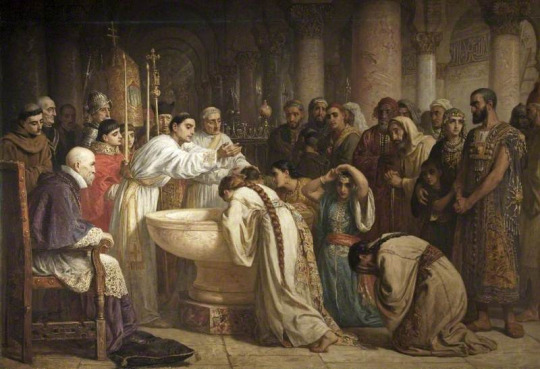
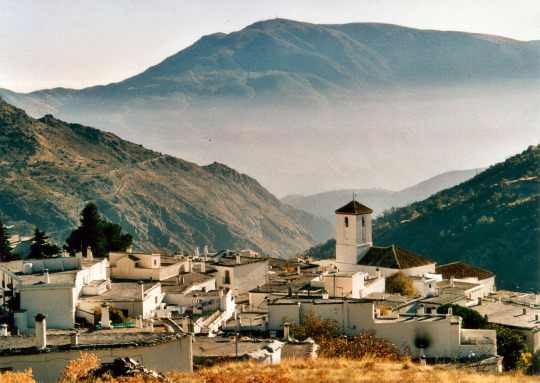
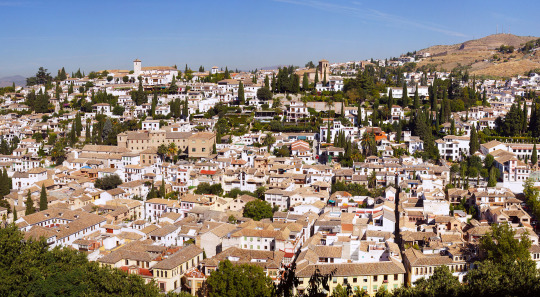
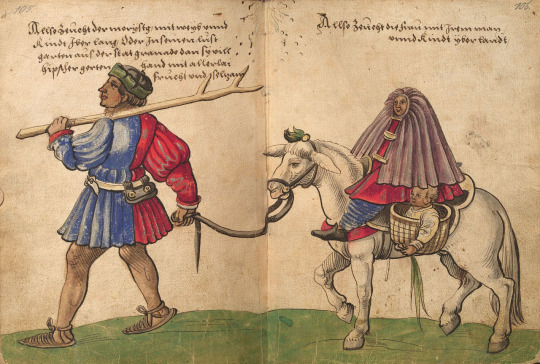
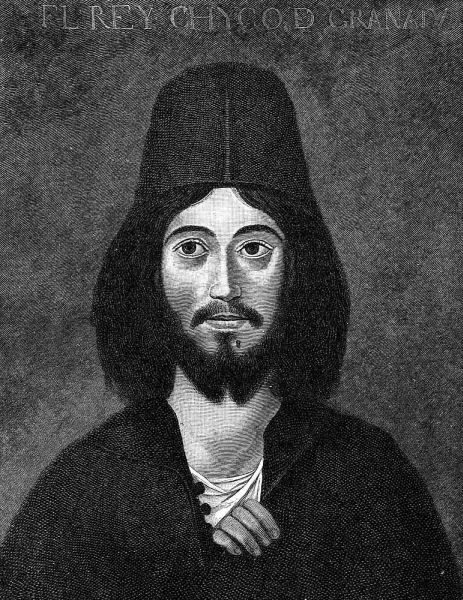
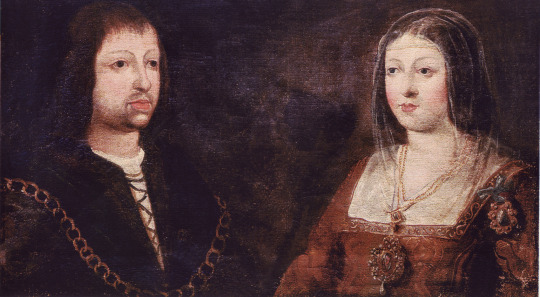
#Moors#morisco#spain#islamic history#islam#spanish inquisition#castile#aragon#portugal#navarre#granada#Emirate of Granada#cordoba#umayyad#Al andalus#military history#alpujarras#Guerilla Warfare#Middle Ages#reconquista#caliphate of cordoba#abbasid#catholic monarchs#ferdinand ii#isabella i of castile#1492#christopher columbus#morocco
5 notes
·
View notes
Text
If anyone wants to read new historical fiction related to the Abd al-Aziz chapter of the Al Andalus. Historical Figures book, recently a novel has been published. This novel is Egilona, Reina de Hispania (Egilona, Queen of Hispania), writen by José Soto Chica. The bulk of the story is based on the texts of the Mozarabic Chronicle and Arabic sources such as the Fath al-Andalus codex, the anonymous Ajbar Maimu'a or the works of the historian Al-Maqqari and the caliph Al-Hakam. In fact, all chapters begin with a fragment of these writings.

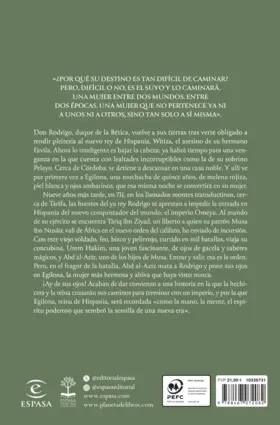
Synopsis
Egilona, the last queen of Hispania, a powerful woman between two cultures, between two eras, the Gothic and the Arab, fascinates us in this memorable historical novel.
Don Rodrigo, Duke of Bética, returns to his lands after being forced to pay homage to the new king of Hispania, Witiza, the murderer of his brother Favila. Now the smart thing is to lower his head; There will be time for revenge. Near Córdoba, he stops to rest in a noble house and there he sees for the first time Egilona, a fifteen-year-old girl with reddish hair, white skin and amber eyes, who that same night will become his wife.
Nine years later, in 711, near Tarifa, the hosts of the now king Rodrigo prepared to prevent the entry into Hispania of the new conqueror of the world: the Umayyad empire. In command of his army is Tariq ibn Ziyad, a freedman whom his patron Musa ibn Nusayr, vali of Africa in the new order of the caliphate, has sent on a raid. With this old soldier, ugly, cross-eyed and red-haired, hardened in a thousand battles, travels his concubine, Umm Hakim, a fascinating young woman, with doe eyes and magical knowledge, and Abd al-Aziz, one of Musa's sons. In and out, that's the order. But, in the heat of battle, Abd al-Aziz kills Rodrigo and sets his sights on Egilona, the most beautiful and haughty woman he has ever seen.
Woe to his eyes! They have just begun a story in which the sorceress and the queen will cross paths to end an empire, and for which Egilona, queen of Hispania, will be remembered "as the hand, the mind, the powerful spirit that sowed the "seed of a new era."
Some comments from the author of the novel about the historical figure of Egilona, the historical setting, the conquest and her marriage to Abd al-Aziz, from this interview:
"Events that have usually been told very poorly"
"She was a transitional character who was everything with the Visigoths and is everything again in the new world of the Muslims, but a lot of nonsense has been written about her"
"I have opted for an intermediate solution in the novel"
"After Rodrigo's death it stands as a symbol of resistance, but after the second defeat of the Visigoths in Écija I made Al-Aziz capture it. Let's think about Aztec Mexico: the Spanish were a very small force and they relied on the nobility. The Arabs did the same. This marriage was not the exception, but the norm, and there are the examples of Teodomiro's daughter or Witiza's granddaughters. It was a time when collaboration was needed"
"If I put on my historian's suit and limit myself to what the sources say, I am tied hand and foot. Now, a novelist does have licenses and I imagine that story of hate and love with Al-Aziz"
"But I think the result is very coherent: it is a novel by a historian who specializes in the period and which, literary speaking, proposes psychological solutions to the 8th century."
"For me, her forgetfulness is intentional from her own time: for those who resisted in Asturias she was a traitor; for the Arabs, she was responsible for the perfect Muslim warrior falling into the conspiracy. She was guilty for going over to the enemy or subverting the order, and this has greatly influenced nineteenth-century and current Spanish historiography"
"This novel, at the level of people who seek to learn history with fiction, is the story of the Islamic conquest of Hispania based on what we really know, which has changed a lot in the last twenty years"
"It's not about good ones and bad ones, but about people like us who have to survive by accepting that the world has changed or by rebelling against it."
#egilona reina de hispania#egilona queen of hispania#bookblr#historical fiction#novel#books#josé soto chica#queen egilona#ailo#king rodrigo#rodrigo king of the goths#abd al-aziz ibn musa#abd al aziz#musa ibn nusayr#tariq ibn ziyad#book scans related#hispania#al andalus#spania#rey don rodrigo#umm hakim
16 notes
·
View notes
Photo
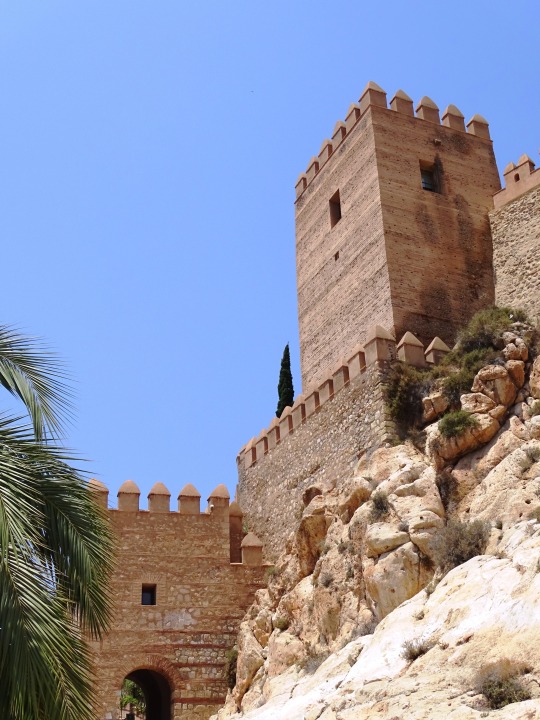

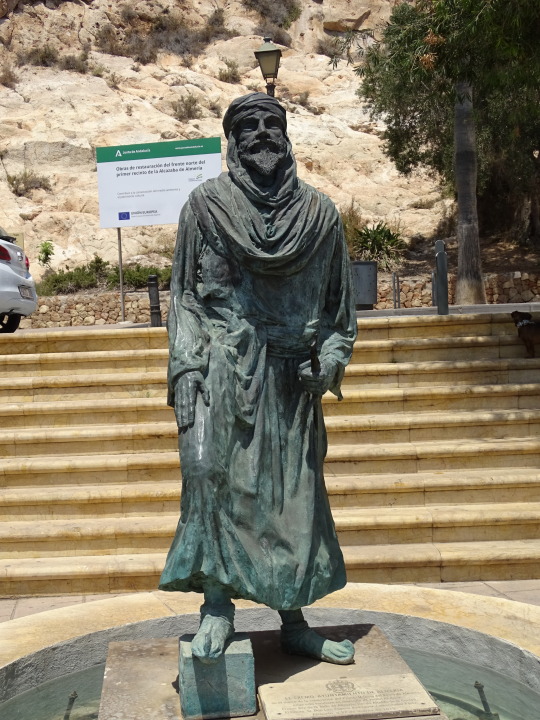

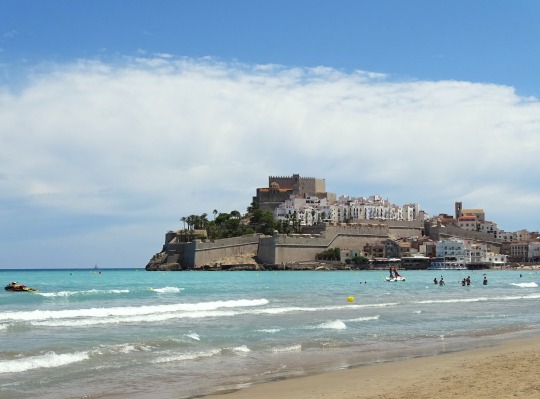

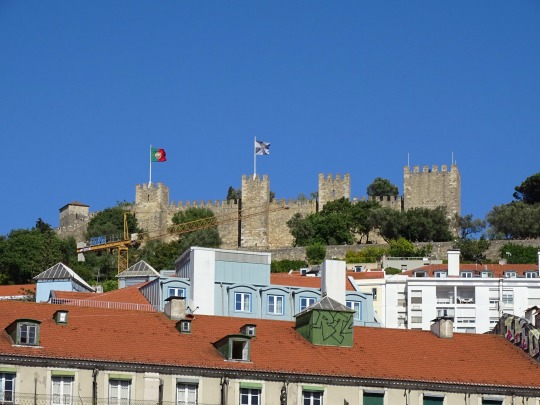
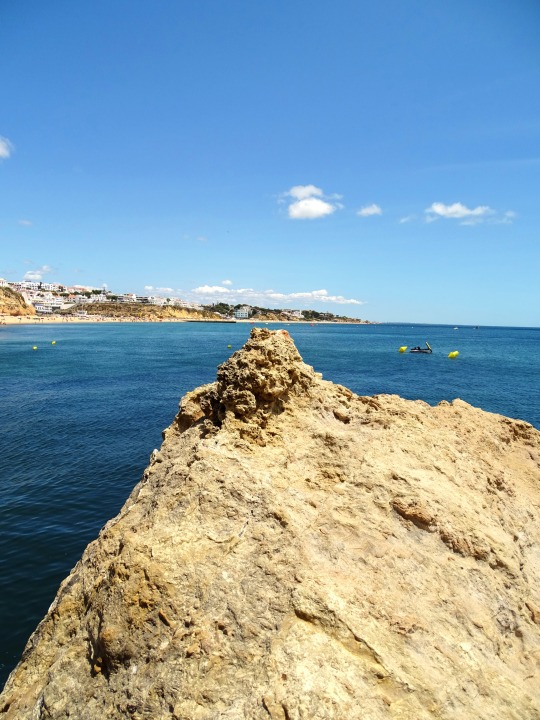


Islamic conquest of Hispania: Moorish troops led by Tariq ibn Ziyad land at Gibraltar to begin their invasion of the Iberian Peninsula (Al-Andalus) on April 27, 711.
#Jayran al-Amiri the first Arab king of Almería#Almeria#Spain#España#travel#Alcazaba y Murallas del Cerro de San Cristóbal#Castillo De La Calahorra#Seviila#Royal Alcázars of Seville#Peñíscola#Mediterranean Sea#Seville Cathedral#São Jorge Castle#Lisbon#Portugal#summer 2021#Albufeira#Atlantic Ocean#Castelló de Farfanya#Castillo de Peñíscola#Islamic conquest of Hispania#27 April 711#anniversary#Spanish history#Portugese history#original photography#architecture#cityscape#tourist attraction
3 notes
·
View notes
Text
Events 7.19 (before 1940)
AD 64 – The Great Fire of Rome causes widespread devastation and rages on for six days, destroying half of the city.
484 – Leontius, Roman usurper, is crowned Eastern emperor at Tarsus (modern Turkey). He is recognized in Antioch and makes it his capital.
711 – Umayyad conquest of Hispania: Battle of Guadalete: Umayyad forces under Tariq ibn Ziyad defeat the Visigoths led by King Roderic.
939 – Battle of Simancas: King Ramiro II of León defeats the Moorish army under Caliph Abd-al-Rahman III near the city of Simancas.
998 – Arab–Byzantine wars: Battle of Apamea: Fatimids defeat a Byzantine army near Apamea.
1333 – Wars of Scottish Independence: Battle of Halidon Hill: The English win a decisive victory over the Scots.
1544 – Italian War of 1542–46: The first Siege of Boulogne begins.
1545 – The Tudor warship Mary Rose sinks off Portsmouth; in 1982 the wreck is salvaged in one of the most complex and expensive projects in the history of maritime archaeology.
1553 – The attempt to install Lady Jane Grey as Queen of England collapses after only nine days.
1588 – Anglo-Spanish War: Battle of Gravelines: The Spanish Armada is sighted in the English Channel.
1701 – Representatives of the Iroquois Confederacy sign the Nanfan Treaty, ceding a large territory north of the Ohio River to England.
1702 – Great Northern War: A numerically superior Polish-Saxon army of Augustus II the Strong, operating from an advantageous defensive position, is defeated by a Swedish army half its size under the command of King Charles XII in the Battle of Klissow.
1817 – Unsuccessful in his attempt to conquer the Kingdom of Hawaiʻi for the Russian-American Company, Georg Anton Schäffer is forced to admit defeat and leave Kauaʻi.
1821 – Coronation of George IV of the United Kingdom.
1832 – The British Medical Association is founded as the Provincial Medical and Surgical Association by Sir Charles Hastings at a meeting in the Board Room of the Worcester Infirmary.
1843 – Brunel's steamship the SS Great Britain is launched, becoming the first ocean-going craft with an iron hull and screw propeller, becoming the largest vessel afloat in the world.
1845 – Great New York City Fire of 1845: The last great fire to affect Manhattan begins early in the morning and is subdued that afternoon. The fire kills four firefighters and 26 civilians and destroys 345 buildings.
1848 – Women's rights: A two-day Women's Rights Convention opens in Seneca Falls, New York.
1863 – American Civil War: Morgan's Raid: At Buffington Island in Ohio, Confederate General John Hunt Morgan's raid into the north is mostly thwarted when a large group of his men are captured while trying to escape across the Ohio River.
1864 – Taiping Rebellion: Third Battle of Nanking: The Qing dynasty finally defeats the Taiping Heavenly Kingdom.
1870 – Franco-Prussian War: France declares war on Prussia.
1900 – The first line of the Paris Métro opens for operation.
1903 – Maurice Garin wins the first Tour de France.
1916 – World War I: Battle of Fromelles: British and Australian troops attack German trenches as part of the Battle of the Somme.
1934 – The rigid airship USS Macon surprised the USS Houston near Clipperton Island with a mail delivery for President Franklin D. Roosevelt, demonstrating its potential for tracking ships at sea.
1936 – Spanish Civil War: The CNT and UGT call a general strike in Spain – mobilizing workers' militias against the Nationalist forces.
0 notes
Text
Today the Church remembers SS. Peter, Walabonsus, Sabinian, Wistremundus, Habentius and Jeremiah, Martyrs.
Orate pro nobis.
Peter, Walabonsus, Sabinian, Wistremundus, Habentius and Jeremiah are numbered among the Martyrs of Córdoba, forty-eight Christian martyrs who were executed under the rule of Muslim administration in Al-Andalus (name given to Spain under Islamic rule). The hagiographical treatise written by the Iberian Christian and Latinist scholar Eulogius of Córdoba describes in detail the executions of the martyrs for capital violations of Islamic law (sharīʿa), including apostasy and blasphemy. The martyrdoms recorded by Eulogius (the only contemporary source) took place between 850 and 859 AD, which, according to the Mālikī judges of al-Andalus, broke the treaty signed between Muslims and their Christian subjects.
In 711 AD, a Muslim army of Moors from North Africa invaded and conquered the territories that previously belonged to the Visigothic Kingdom of Spain, which comprised the Christian Iberia peninsula. Under their leader Tariq ibn-Ziyad, they landed at Gibraltar and brought most of the Iberian Peninsula under Islamic rule in an eight-year campaign. The Iberian Peninsula was called Al-Andalus by its Muslim rulers. When the Umayyad caliphs were deposed in Damascus in 750 AD, the dynasty relocated to Córdoba, ruling an emirate there; consequently the city gained in luxury and importance, as a center of Iberian Muslim culture.
Once the Muslims had conquered Iberia, they governed it in accordance with Islamic law (sharīʿa). Blasphemy and apostasy from Islam were both capital offenses. In the Islamic religion, blasphemy includes insulting Muhammad and the Muslim religion. Apostasy is the crime of converting away from Islam. Under Islamic law, anyone whose father is Muslim is automatically a Muslim at birth and will automatically be guilty of apostasy if they proclaim any faith other than Islam. Anyone found guilty of either blasphemy or apostasy is swiftly executed in accordance with the Islamic death penalty.
The forty-eight Christians (mostly monks) were martyred in Córdoba, between the years 850-859 AD, being decapitated for announcing their apostasy publicly and blaspheming against Mohammed.
Peter, Walabonsus, Sabinian, Wistremundus, Habentius and Jeremiah were all murdered on June 7, 851 AD. Peter was a priest; Walabonsus, a deacon; Sabinian and Wistremundus, monks of St Zoilus in Córdoba in Al-Andalus; Habentius, a monk of St Christopher's; Jeremiah, a very old man, had founded the monastery of Tábanos, near Córdoba. For publicly denouncing Muhammad they were executed under Abderrahman in Córdoba. Jeremiah was scourged to death; the others were beheaded.
Almighty God, who gave to your servants Peter, Walabonsus, Sabinian, Wistremundus, Habentius and Jeremiah boldness to confess the Name of our Savior Jesus Christ before the rulers of this world, and courage to die for this faith: Grant that we may always be ready to give a reason for the hope that is in us, and to suffer gladly for the sake of our Lord Jesus Christ; who lives and reigns with you and the Holy Spirit, one God, forever and ever.
Amen.
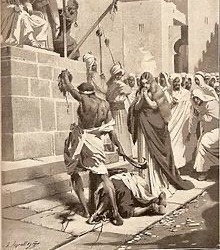
#father troy beecham#christianity#jesus#saints#god#salvation#peace#martyrs#faith#early church#christian persecution#Islam
1 note
·
View note
Text
AUTRES DIMENSIONS DE SA PROPHÉTIE : Partie 5
LE GÉNIE CRÉÉ PAR LE MESSAGER
Il est difficile pour nous de comprendre parfaitement le Prophète Mohammed. Parce que nous avons tendance à compartimenter l'univers, la vie, et même l'humanité elle-même, nous n'avons pas de vision unitaire. Or le Prophète Mohammed réunissait en sa personne à la fois l'intelligence d'un philosophe, la bravoure d'un commandant, le génie d'un homme de science, la prudence d'un sage, la perspicacité d'un homme d'Etat, le talent administratif, la profondeur spirituelle d'un maître soufi et le savoir d'un grand savant.
Les philosophes produisent des élèves, pas des adeptes; les leaders sociaux et révolutionnaires font des patriotes, pas des gens complets; les maîtres soufis font des «seigneurs de soumission», pas des intellectuels ou des combattants actifs. Or chez le Prophète Mohammed nous trouvons les caractéristiques d'un philosophe, d'un leader révolutionnaire, d'un guerrier, d'un homme d'Etat et d'un maître soufi. La sienne est une école de la pensée, de l'intelligence, de la révolution, de la soumission et de la discipline, de la bonté, de la beauté, de l'extase et de l'action.
Le Prophète Mohammed transforma des Arabes du désert brutaux, ignorants, sauvages et obstinés en une communauté d'adeptes sincèrement dévoués à une cause sublime, une société de douceur et de compassion, une assemblée de sainteté, et une légion d'intellectuels et de savants. Nous ne pouvons voir nulle part ailleurs une telle ferveur et un tel zèle alliés à la douceur, la gentillesse, la sincérité et la compassion. Cette caractéristique est propre à la communauté musulmane et a été manifeste depuis ses premiers jours.
Le «Jardin» de Mohammed
L'islam - l'école du Prophète Mohammed - a été un jardin riche de toutes sortes de fleurs. Pareil à une fontaine d'eau, Dieu en a fait jaillir des êtres majestueux tels qu'Abou Bakr, Omar, Othman, Ali, Omar ibn Abd al-Aziz, Mahdi al-Abbasi, Harun ar-Rashid, Alp Arslan, Mehmed le Conquérant, Selim et Sulayman. Ils étaient non seulement des hommes d'Etat du plus haut calibre et des commandants invincibles, mais aussi des hommes d'une profonde spiritualité, d'un grand savoir, dotés de talents d'orateur et de littérature.
L'atmosphère pure et bénie du Messager produisit d'invincibles généraux. Parmi la première génération l'on peut voir des génies militaires tels que Khalid, Sa'd ibn Abi Waqqas, Abou Ubayda, Shurahbil ibn Hasana et A'la al-Khadhrami. Ils furent succédés par de brillants généraux comme Tariq ibn Ziyad et Uqba ibn Nafi, qui tous deux alliaient le génie militaire à la tendresse humaine et la conviction et la dévotion religieuses.
Quand Uqba, le conquérant de l'Afrique du Nord, atteignit l'océan Atlantique, à plus de 3000 kilomètres de l'Arabie, il s'exclama: «Et maintenant, Dieu! N'eût été cette mer qui s'étend devant moi, j'aurais transmis Ton Nom, la source de lumière, jusqu'aux coins les plus reculés de la planète!» Difficile d'imaginer Alexandre le 'Grand' avoir de telles pensées quand il se lança vers la conquête de la Perse. Mais en tant que conquérants, les deux hommes accomplirent des exploits comparables.
L'idéalisme de Uqba et sa «capacité» eu égard à la Volonté Divine allaient être transmutés en une action irrésistible dans ce monde. L'empire d'Alexandre s'effondra après sa mort; les terres que Uqba avaient conquises maintiennent à ce jour l'islam comme leur principale vision du monde, leur credo et leur style de vie, et cela quatorze siècles plus tard, en dépit des tentatives faites pour changer cette réalité.
Tariq fut un victorieux commandant, pas seulement quand il vainquit une armée de 90 000 Espagnols avec une poignée d'hommes vaillants et prêts à tout sacrifice, mais aussi quand il se tint debout devant le trésor du roi et se dit: «Prends garde Tariq! Pas plus tard qu'hier tu n'étais encore qu'un esclave. Aujourd'hui, tu es un commandant victorieux. Et demain tu seras sous la terre.»
Yavuz Selim, un Sultan ottoman qui considérait que le monde était trop étroit pour deux dirigeants, fut réellement victorieux quand il couronna quelques rois et en détrôna d'autres, et aussi quand il entra en silence à İstanbul à l'heure du coucher, après avoir conquis la Syrie et l'Egypte, afin d'éviter l'accueil enthousiaste du peuple. Il fut aussi victorieux quand il ordonna que la robe tachée de boue par le cheval de son maître-enseignant fût placée sur son cercueil en raison de son caractère sacré - elle avait été tachée de boue par le cheval d'un savant.
Durant les conquêtes rapides qui suivirent le décès du Prophète, beaucoup de captifs étaient distribués parmi les familles musulmanes. Ces esclaves émancipés devinrent finalement de grands savants religieux: Hasan al-Basri (Basra); Ata ibn Rabah, Mujahid, Sa'id ibn Jubayr, et Sulayman ibn Yassar (La Mecque); Zayd ibn Aslam, Muhammad ibn al-Munkadir, et Nafi ibn Abi Nujayh (Médine); Alqama ibn Qays an-Nakha'i, Aswad ibn Yazid, Hammad, et Abou Hanifa Nu'man ibn Thabit (Koufa); Tawus and ibn Munabbih (Yémen); Ata ibn Abd Allah al-Khorasani (Khorasan); et Maqhul (Damas). Ils s'épanouirent tous comme des fleurs parfumées dans le jardin de Mohammed. Ils établirent le code légal islamique et élevèrent des milliers de juristes, qui écrivirent et compilèrent des recueils que l'on estime toujours comme des références légales.
L'un de ces juristes, Imam Abou Hanifa, fonda l'école juridique Hanéfite, qui compte aujourd'hui des centaines de millions d'adeptes. Il forma de grands savants tels que Imam Abou Youssouf, Imam Zufar, et Imam Muhammad, Hasan ash-Shaybani, qui fut le maître-enseignant d'Imam Muhammad Idris ash-Shafi'i. Les notes d'Abou Hanifa dictées à Imam ash-Shaybani furent expliquées des siècles plus tard par Imam Sarakhsi («le soleil des imams») dans Al-Mabsut, un ouvrage en trente volumes.
Imam Shafi'i, qui établit les principes de méthodologie de la loi islamique, est considéré comme un réformateur des sciences religieuses. Pourtant, quand ses élèves dirent à Imam Sarakhsi que Imam Shafi'i avait mémorisé 300 fascicules de Traditions Prophétiques (hadiths), ce dernier répondit modestement: «Il avait la zakat (un quarantième) des hadiths que j'ai mémorisés». Imam Shafi'i, Abou Hanifa, Imam Malik, ou encore Ahmad ibn Hanbal, et beaucoup d'autres, furent formés dans l'école du Prophète Mohammed.
Aussi y a-t-il des exégètes coraniques tels que Ibn Jarir at-Tabari, Fakhr ad-Din ar-Razi, Ibn Kathir, Imam Suyuti, Allama Hamdi Yazir et Sayyid Qutb. En outre, il y a eu de célèbres rapporteurs de hadiths comme Imam Boukhari, Mouslim, Tirmidhi, Abou Dawoud, Ibn Maja, Nasa'i, Ibn Hanbal, Bayhaqi, Darimi, Daraqutni, Sayf ad-Din al-Iraqi, Ibn Hajar al-Asqalani et beaucoup d'autres. Tous sont des étoiles toujours scintillantes dans le ciel lumineux des sciences islamiques. Tous reçurent leur lumière du Prophète Mohammed.
Selon l'islam, Dieu créa l'être humain sous la meilleure forme, comme étant le théâtre le plus universel et le plus complet des Noms et des Attributs Divins. Mais les gens, à cause de leur insouciance, peuvent tomber aux niveaux les plus bas. Le soufisme, dimension intérieure de l'islam, conduit les gens à la perfection ou leur permet de réacquérir leur état angélique originel. L'islam a engendré d'innombrables saints. Comme il n'a jamais séparé notre quête ou gnose métaphysique de l'étude de la nature, beaucoup de soufis pratiquants furent aussi des hommes de science. De grands saints comme Abd al-Qadir al-Jilani, Shah Naqshband, Ma'ruf al-Karkhi, Hassan Shazili, Ahmad Badawi, Shaykh al-Harrani, Ja'far al-Sadiq, Junayd al-Baghdadi, Bayazid al-Bistami, Muhy ad-Din al-Arabi, et Mawlana Jalal ad-Din ar-Rumi ont illuminé la voie de la vérité et appris à beaucoup d'autres personnes à purifier leur ego.
Etant des incarnations de la sincérité, de l'amour divin et des intentions pures, les maîtres soufis devinrent la force motrice de la source de pouvoir derrière les conquêtes islamiques et la conséquente islamisation de ces terres. Des figures comme Imam Ghazali, Imam Rabbani et Bediuzzaman Said Nursi sont des réformateurs du plus haut degré, et alliaient en eux-mêmes la lumière des sages, la connaissance des savants religieux et la spiritualité des grands saints.
L'islam est la voie du juste milieu. Sa hiérarchie détaillée des connaissances est intégrée par le principe de l'Unité Divine. Il y a des sciences juridiques, sociales, théologiques et métaphysiques qui dérivent leurs principes du Coran. Avec le temps, les musulmans développèrent des sciences philosophiques, naturelles et mathématiques complexes, chacune ayant sa source dans l'un des Beaux Noms de Dieu (Asmâ-ul-Husna). Par exemple, la médecine dépend du Nom le Tout-Guérisseur; la géométrie et l'ingénierie reposent sur les Noms le Tout-Juste et le Tout-Déterminant, et le Tout-Formateur et le Tout-Harmonisant; la philosophie reflète le Nom le Tout-Sage.
Chaque niveau de connaissance voit la nature sous un éclairage particulier. Les juristes et les théologiens la voient comme le cadre de l'action humaine; les philosophes et les scientifiques la voient comme un domaine à analyser et à comprendre; et les métaphysiciens la considèrent comme l'objet de contemplation et le miroir reflétant les réalités suprasensibles. L'Auteur de la nature a inscrit Sa Sagesse sur chaque feuille et chaque pierre, sur chaque atome et chaque particule, et a créé le monde de la nature d'une telle manière que chaque phénomène est un signe chantant la gloire de Son Unicité.
L'islam a maintenu une connexion intime entre les études islamiques et scientifiques. Ainsi, l'éducation traditionnelle des hommes de science musulmans, surtout durant les premiers siècles, comprenait la plupart des sciences contemporaines. Plus tard dans leurs vies, l'intérêt et le talent de chacun d'eux allaient en faire un expert spécialisé dans une ou plusieurs sciences.
Les universités, les bibliothèques, les observatoires et les autres institutions scientifiques jouèrent un rôle majeur dans la continuation de la vitalité de la science islamique. Ces lieux, ainsi que les étudiants qui faisaient des centaines de milliers de kilomètres pour étudier auprès de savants reconnus, assurèrent que le recueil intégral des connaissances fût gardé intact et transmis d'un endroit à l'autre et d'une génération à l'autre. Ce savoir ne resta pas statique; loin de là, il continua à s'élargir et à s'enrichir. Aujourd'hui, il y a des centaines de milliers de manuscrits islamiques (principalement en arabe) dans les bibliothèques du monde entier, dont un grand nombre traite de sujets scientifiques.
Par exemple, Abou Youssouf Ya'qub al-Kindi («le Philosophe des Arabes») écrivit, entres autres, sur la philosophie, la minéralogie, la métallurgie, la géologie, la physique et la médecine, et était un physicien accompli. Ibn al-Haytham était un grand mathématicien musulman et, sans aucun doute, le plus grand physicien. Nous connaissons les noms de plus de cent de ses ouvrages. Quelque dix-neuf d'entre eux, traitant des mathématiques, de l'astronomie et de la physique, ont été étudiés par des savants modernes. Son travail influença profondément les savants des siècles suivants, à la fois dans le monde musulman et en Occident, où il était connu sous le nom d'Alhazen. L'un de ses livres sur l'optique fut traduit en latin en 1572.
Abou ar-Rayhan al-Biruni était l'un des plus grands savants de l'islam médiéval, et certainement le plus original et le plus profond. Il était également versé dans les mathématiques, l'astronomie, les sciences naturelles et physiques, et se distingua aussi en tant que géographe et historien, chronologiste et linguiste, et en tant qu'observateur impartial des coutumes et des credos. On se souvient encore aujourd'hui des figures telles que al-Khawarizmi (mathématiques), Ibn Shati'i (astronomie), al-Khazini (physiques), Jabir ibn Hayyan (médecine). L'Andalousie (l'Espagne musulmane) était le principal centre à partir duquel l'Occident acquit le savoir et l'illumination des siècles.
L'islam fonda une civilisation des plus brillantes. Cela ne devrait pas être considéré surprenant, car le Coran commence avec l'injonction: Lis, au nom de ton Seigneur qui crée. (96:1) Le Coran enjoignit aux gens de lire alors qu'il n'y avait pas grand chose à lire et que la majorité de la population était illettrée. Ce que nous comprenons de ce qui semble d'abord être paradoxal est que l'humanité doit «lire» l'univers comme le «Livre de la Création».
Son équivalent est le Coran, un livre de lettres et de mots. Il nous faut observer l'univers, percevoir sa signification et son contenu, et à travers ces activités gagner une plus profonde perception de la beauté et de la splendeur du système du Créateur et de l'infinitude de Sa Puissance. Ainsi sommes nous obligés de nous approfondir dans l'étude des multiples sens de l'univers, découvrir les lois de la nature, et établir un monde dans lequel la science et la foi se complémentent. Tout cela nous permettra d'atteindre le vrai bonheur dans les deux mondes.
Obéissant aux injonctions coraniques et à l'exemple du Prophète, les musulmans étudièrent le Livre de la Révélation Divine (le Coran) et le Livre de la Création (l'univers), et finirent par ériger une grande civilisation. Des savants de toute l'Europe profitèrent des centres d'éducation supérieure situés à Damas, à Boukhara, à Bagdad, au Caire, à Fez, à Qairwan, à Zeituna, à Cordoue, en Sicile, à Ispahan, à Delhi et dans d'autres grandes villes islamiques. Les historiens comparent le monde musulman de la période médiévale - obscure pour l'Europe, mais dorée et toute de lumières pour les musulmans - à une ruche. Les rues étaient pleines d'étudiants, d'hommes de science et de savants voyageant d'un centre d'éducation à un autre.
Pendant les cinq premiers siècles de son existence, le royaume de l'islam vécut une grande ère de progrès et de civilisation. Parsemé de splendides villes, de gracieuses mosquées et d'universités, l'Orient musulman offrait un contraste marquant avec l'Occident chrétien qui se noyait dans les ténèbres de l'obscurantisme. Même après les terribles invasions mongoles et les croisades du XIIIe siècle et d'après, il resta énergique et bien en avance par rapport à l'Occident.
Bien que l'islam régnât sur les deux tiers du monde civilisé connu pendant au moins onze siècles, la paresse et la négligence de ce qui se passait au-delà de ses frontières entraînèrent sa décadence. Toutefois, il faut souligner clairement que ce déclin concerne seulement la civilisation islamique - pas l'islam. La supériorité et les victoires militaires, qui continuèrent au XVIIIe siècle, encouragèrent les musulmans à se reposer sur leurs lauriers et à négliger de faire des recherches scientifiques plus poussées. Ils se laissèrent aller à vivre leurs propres vies, et récitaient le Coran sans étudier ses significations plus profondes. Pendant ce temps, l'Europe faisait de grands progrès dans des sciences qu'ils avaient empruntées aux musulmans.
Ce que nous appelons «sciences» sont en réalité les diverses langues du Livre Divin de la Création (un autre aspect de l'islam). Ceux qui ignorent ce livre sont voués à l'échec dans ce monde. Quand les musulmans commencèrent à ne plus y prêter attention, ce n'était plus qu'une question de temps avant qu'ils ne fussent dominés par quelque force extérieure. Dans notre cas, la force extérieure était l'Europe. Les attaques incessantes des puissances européennes et le colonialisme contribuèrent beaucoup à ce résultat.
Chaque civilisation a ses propres caractéristiques qui la distinguent des autres. La civilisation moderne actuelle, bien qu'ayant fait de grandes contributions au développement de l'humanité dans les domaines des sciences et de la technologie, principalement matérialiste, est très loin de satisfaire les besoins perpétuels de l'humanité. C'est à cause de cela que selon beaucoup de sociologues comme Oswald Spengler, elle ne saurait durer longtemps. Spengler a prédit son déclin du fait que cette civilisation va à l'encontre de la nature et des valeurs humaines. Le monde éclairé du futur sera construit sur la base solide de l'alliance des sciences avec la foi, la spiritualité et la moralité, et il attachera aussi l'importance due aux valeurs et aux droits humains fondamentaux. L'islam fera la plus grande contribution à ce monde-là.
#musulman#coran#allah#dieu#islam#se convertir#converti#convertie#revert#reverthelp#equipe reverthelp#converthelp#musulman revert#musulman converti#se convertir à l'islam#islam revert#rappel#prière#salah#dua#prier#musulmane#hiajb#hijabi#muhammad#bienvenu en islam#converti à islam#comment se convertir à islam#religion
0 notes